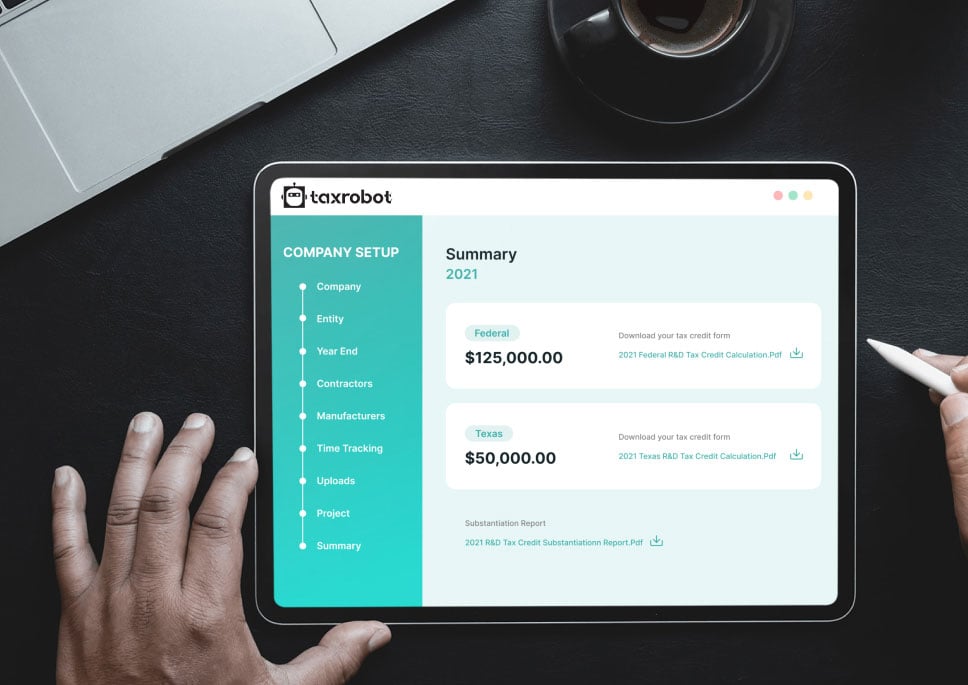Maryland R&D Credit
Get in touch with us and make it easier to claim the R&D tax credit your business qualifies for.
Maximize your State Credits today!
Put the R&D tax credit process on autopilot.
Trusted By:








Maryland R&D Credit
Discover your eligibility for Maryland R&D tax credits and supercharge your enterprise.
Are R&D Tax Credits Available in Maryland?
Yes, Maryland does offer R&D tax credits as a tax incentive to those businesses that are eligible. These businesses must have qualified research expenses originating in Maryland. This tax credit is available through June 30, 2027, when it expires. However, this expiration date is subject to extension by the Maryland General Assembly.
Businesses in Maryland can claim both the Maryland R&D credit and the federal credit to maximize their tax savings.
Eligibility
Maryland follows the same requirements as the IRS when determining which activities and expenses qualify as part of the credit. This means you can use Section 41 to determine which expenses are eligible. It also means your Maryland qualifying expenses should also qualify for the federal tax credit.
The Four-Part Test
In order to qualify for both the Maryland and federal tax credit, research activities must pass a four-part test. This means the activities must:
- Be technological in nature
- Be within the permitted purpose
- Eliminate technological uncertainty
- Follow a process of experimentation
Refundability
If your tax credits are more than your income tax liability for the taxable year, you may be eligible to have the excess refunded. Businesses that qualify are small businesses with net book value assets under $5,000,000. This includes sole proprietorships, partnerships, LLCs, and for-profit corporations.
How Much Is the Tax Credit?
In Maryland, you can claim two types of R&D tax credits, the Basic R&D tax credit and the Growth R&D tax credit. Plus, you’re most likely also eligible for the federal credit too.
- Maryland Base Amount:
You’ll need to determine your base amount, as the basic and growth tax credit amounts will be based on this. You can find this by dividing your aggregate qualifying expenses by your aggregate gross receipts for the prior four years.
- Basic R&D Tax Credit:
The Basic credit is 3% of the eligible expenses not exceeding the Base Amount. This credit will be prorated if the total amount applied for exceeds $5.5 million.
- Growth R&D Tax Credit:
The Growth tax credit is 10% of eligible expenses exceeding the Maryland Base Amount. This credit will be prorated if the total credits applied for exceeds $6.5 million.
- Federal R&D Tax Credit:
The amount for the federal tax credit can be a bit more difficult to figure out. In general, you might qualify for 6-8% of your R&D expenses.
How to Apply
The deadline to submit your application is November 15 for expenses you incurred during the previous calendar year. The application must be completed online using the state’s system. If you’re approved, you’ll receive a certification letter stating your approved credit amount by the following February 15.
You can then file an amended tax return or claim the credit in up to seven subsequent tax years. Just be sure to attach a copy of your Certification Letter to your Maryland income tax return.
Make Claiming the Maryland R&D Tax Credit Easier
Determining which expenses qualify and calculating what they add up to can be a lot. Luckily, TaxRobot is here to help. We make the process simple with our software developed by subject matter experts. After you provide us with some information, we’ll be able to process the rest, cutting down the time it takes you by up to half.
Plus, we’ll back it up with audit-proof documentation and field any questions and requests if you’re audited.
Find Out How Much Credit You May Be Owed
Use our calculator to estimate how much R&D tax credit you may qualify for. Then get started claiming what you’re eligible for.
Take a sneak peak

- Limited Time Offer
- Simple Onboarding
- Easy to Use
R&D Tax Credits FAQs
The four-part test as outlined in the Internal Revenue Code is used to determine qualified R&D activity.
The Four-Part Test
1). New Or Improved Business Component
Creation of a new product, process, formula, invention, software, or technique; or improving the performance, functionality, quality, or reliability of existing business component.
- Construction of new buildings or renovation of existing buildings
- Invention of a software application
- Manufacturing of a new product or the improvement of the production process for an existing product
- Creation of design documentation
2). Technological In Nature
The activity fundamentally relies on principles of the physical or biological sciences, engineering, or computer science. A taxpayer does not need to obtain information that exceeds, expands or refines the common knowledge of skilled professionals in a particular field.
- Physics (relationship between mass, density and volume; loading as the
result of gravitational attraction) - Engineering (mechanical, electrical, civil, chemical)
- Computer science (theory of computation and design of computational systems)
3). Elimination Of Uncertainty
Uncertainty exists if the information available to the taxpayer does not establish the capability or method for developing or improving the business component, or the appropriate design of the business component.
- The capability of a manufacturer to create a part within the specified tolerances
- The appropriate method of overcoming unsuitable soil conditions during construction
- The appropriate software design to meet quality and volatility requirements
4). Process Of Experimentation
A process designed to evaluate one or more alternatives to achieve a result where the capability or method of achieving that result, or the appropriate design of that result, is uncertain as of the beginning of the taxpayer’s research activities.
- Systematic process of trial and error
- Evaluating alternative means and methods
- Computer modeling or simulation Prototyping Testing
The R&D tax credit is one of the most misunderstood tax incentives available. Considering the myriad of industries and activities that legally qualify for the credit, the term “research and development” is a misnomer. Additionally, the R&D tax credit requires specialized knowledge and technology to identify and calculate the incentive properly.
Companies of various industries are unaware that they are eligible to claim the R&D tax credit. Under the Internal Revenue Code’s definition of R&D, many common activities qualify. You can get tax benefits for industries including software, technology, architecture, engineering, construction, manufacturing, and more.
The R&D tax credit can be claimed for all open tax years. Generally, open tax years include the prior three tax years due to the statute of limitations period. In certain circumstances, the law allows businesses to claim the R&D tax credit for an extended period of time. It is common for companies to amend previous tax years to claim this benefit and reduce the maximum amount of tax liability.
Partnerships and S corporations must file this form to claim the credit. The credit will flow from the Form 6765, to the Schedule K-1, to the Form 3800 on the individual’s tax return. For individuals receiving this credit that have ownership interest in a partnership or S corporation, Form 6765 is not required on the individual return.
Individuals claiming this credit can report the credit directly on Form 3800, General Business Credit if their only source for the credit is a partnership, S corporation, estate, or trust. Otherwise, Form 6765 must be filed with the individual’s tax return (e.g. sole proprietorship).
For tax years prior to 2016, the credit can be used to reduce the taxpayer’s regular tax liability down to the tentative minimum tax. The credit cannot be used to offset alternative minimum tax. Beginning in tax year 2016, eligible small businesses have expanded utilization for the credit. For these eligible small businesses, the regular tax liability can offset alternative minimum tax using the “25/25” rule.
What our customers have to say
I highly recommend TaxRobot to anyone considering an R&D Tax Credit software to complete their analysis.

We decided to switch to TaxRobot… Best decision we’ve ever made. More affordable, and less complicated.

I couldn’t believe how easy it was! In under an hour, we saved enough money to hire a new employee.
